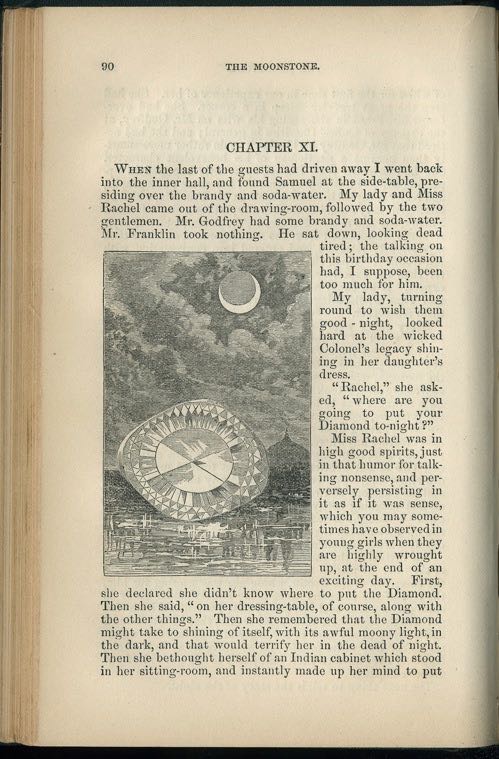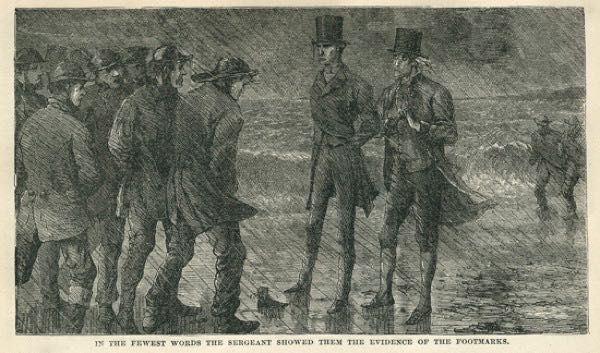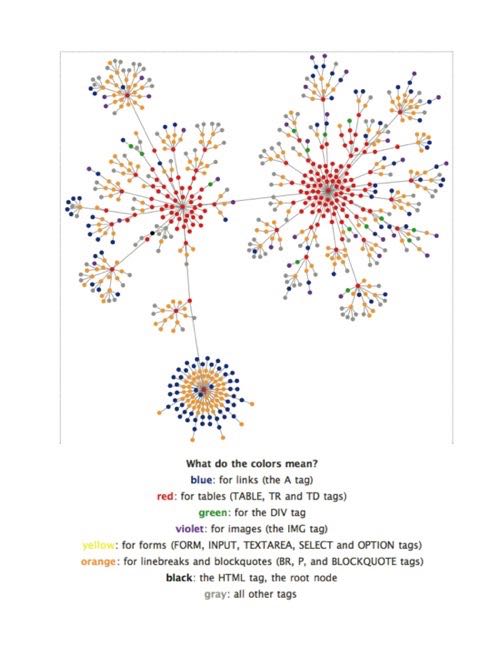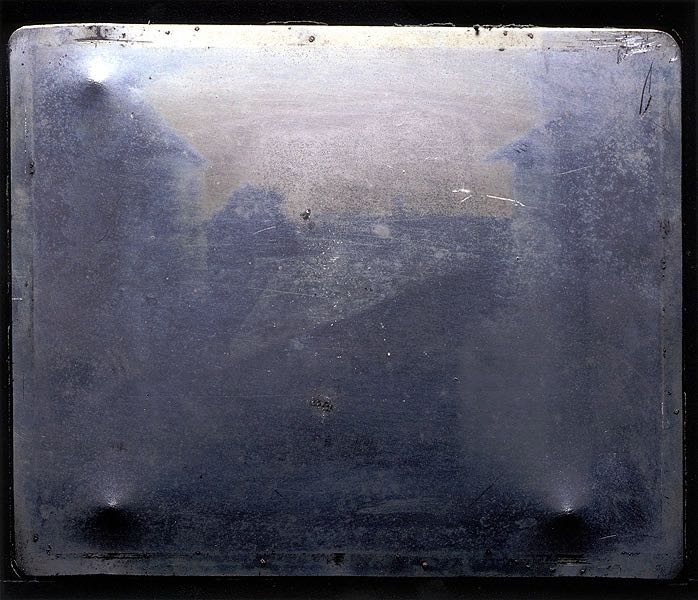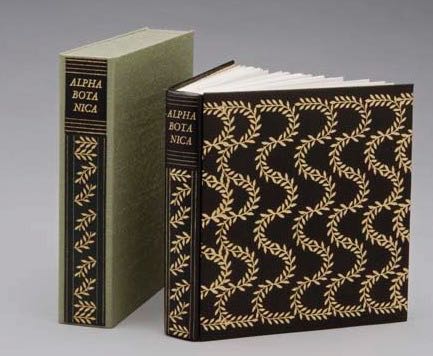
March 2010

27 March 10
Strange & Wonderful
— Strange and Wonderful. An Informal Visual History of Manuscript Books and Albums. Introduction by Jed Perl. Designed by Fabio Cutro. Sanctuary Books, 2010.
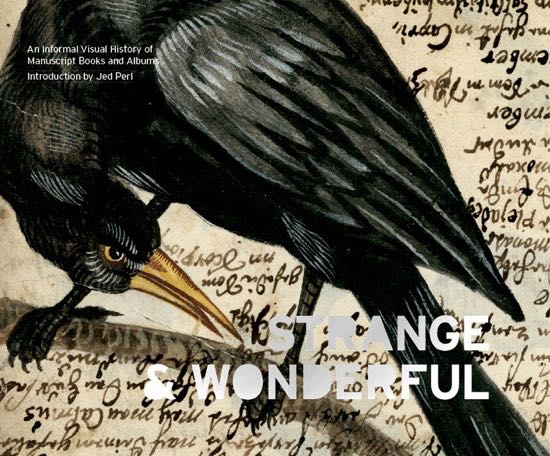
This is the book I want to read !
My friend Dan Wechsler, publisher of the book and proprietor of Sanctuary Books in NYC, reports that he has received finished books from his printer. I expect to have a review copy early next week. Stay tuned. The official publication date is 8 April, to coincide with the opening of the New York Antiquarian Book Fair.

Thank you, Dan.
Report from the Field : Cornell

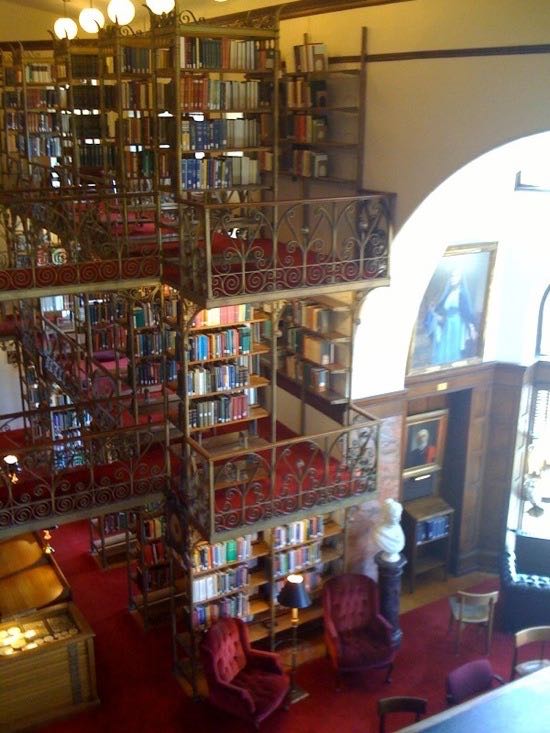
Thanks to special correspondent [PW].
Rhinestone Manifesto
“ The pale fire in the rhinestone matrix reddened because of the windowpane’s reply. ”
Today I re-read “ Rhinestone Manifesto ” by Don Webb (Interzone 13, Autumn 1985) for the first time in at least 12 years, and it is still as wild as I remembered, and as affecting. After reading that story, and that issue, with a William Gibson interview and a cover story by J.G. Ballard — the first time I encountered Interzone — I was conscious that science fiction was where I wanted to be. For many years I kept that copy of Interzone but I am certain that I no longer had it in the fall of 1999, or I would have cited a pasage from “ Rhinestone Manifesto ” in my critical fiction “ Book Becoming Power ”.
I had not remembered that “ Rhinestone Manifesto ” was Don Webb’s first professional sale. I feel lucky to have made the connection from day one. Sometime in 1993, we began to exchange letters, and Webb was one of my first e-mail correspondents. In October 2006 Temporary Culture published When They Came , but it was not until a recent trip to Austin that we two met in person. I look forward to reading his next book.
24 March 10
— Wilkie Collins. The Moonstone. A Novel . With illustrations. Harper & Brothers, Publisher, [1875]. Harper’s Library Edition. Re-reading this for the first time since boarding-school days. Just a few chapters in, and enjoying the layers of story, the meandering narration of Betteredge, whose chapters combine elements of Tristram Shandy and Thady Quirk, the aged family servant who recounts Castle Rackrent . Also the urgency: Necessity as Structure : this is a tale that MUST be told. Page 90, with the engraving in the text (above), is a great example of late nineteenth-century American book illustration. Link to large scan of the page here.
The Light in Davenport
— Guy Davenport. Tatlin ! Six Stories . 1974; Johns Hopkins University Press paperback, 1982).
Having pulled this down from a shelf and looked into one story, “ 1830 ”, and then another, and so forth, I notice in Davenport’s layered prose — his images always as rich visually as verbally — how carefully the light is invoked :
Our sense of the old is always modern. Starlight is hundreds of years old. We live in the phoenix time of antiquity. ( “ 1830 ” ).
Perhaps only in the awful light of the extraordinary was there real calm in human action. ( “ The Aeroplanes at Brescia ” ).
At Drachenberg, the bears’ skulls sat on their ledges hooded in dust older than Ur or Dilmun. Their muzzles all pointed to the rising sun, which fell on them dimly in the depths of their cave in the cliff, lighting all but the sockets of their eyes. ( “ Robot ” ).
Matter is stilled light. ( “ The Dawn in Erewhon ” ).
To find a source for this energy of attention, consult Herakleitos (tr. Davenport) : “ an everlasting fire, dying and flaring up again ”.
Shreds ; or, Miscellaneous Topics
‘ Pay attention to the storytelling ’
— In the current issue of The New York Review of Science Fiction for
March 2010, Darrell Schweitzer reviews Hope-in-the-Mist by Michael
Swanwick. I cite only this snippet : “ read Swanwick and pay
close attention to why his work is so good. Then examine some particularly boring
paper or biography. Compare the way the narrative is handled. Pay attention to
the storytelling. ” Subscribe here.
Book Patrol
— Book Patrol. A Haven for Book Culture. A wide ranging blog on bookish
subjects, usually with lots of visual elements. Link here: http://www.bookpatrol.net
Temporary Culture
The Man with the Knives by Ellen Kushner (forthcoming in May) will go into production this week as the first of the drawings by Thomas Canty have been received. Details and ordering information here. Further updates will include some visual details.
the website as graph
http://www.aharef.info/static/htmlgraph/?url=http://endlessbookshelf.net
The link appears to be generative and what you see will likely differ
from the image above.
(via Rudy Rucker)
21 March 10
Recent reading :
— Serge Combard. Le ministère du gel .
Robert Laffont, 1967.
Satirical novel of a near future France (ca. 2017), a prosperous socialist
republic stretching from the Atlantic to the Urals, very elevated literary
in style and allusions, but describing (retrospectively) a society in which
the machines are just about to take over. Principal character is Serge, an
elderly but vigorous man of letters and académicien who refuses the
compulsory cryogenic immortality to which his family is to be the test model,
preferring to live and die in the accustomed way. Bullet trains, the ministry
of Happiness, quasi-intelligent machines, and lyrical descriptions of the
cryogenic immortality which Serge rejects. Written by an insider with experience
of how the French government works, with some very astute and beautifully
phrased observations about computers and humanity, and most interesting of
all, an interesting predictive critique of the surveillance society.
La puissance des ordinateurs vient de la masse des informations qu’ils détiennent. Ils peuvent à tout moment mettre en relation des séries causales indépendants. Cela leur donne dur le Français moyen, cet être fataliste quie confie souvent son destin au hasard et à la combine, un avantage terrifiant. Les ordinateurs contrariement au bon peuple n’ont jamais cru au hasard. Pour eux le hasard n’est qu’un manque d’information.
The title is a reference to a passage from Coleridge (epigraph for the book) :
. . . Or if the secret ministry of frost
Shall hang them up in silent icicles,
Quietly shining to the quiet Moon.
— Eric Leif Davin. Partners in Wonder. Women and the Birth of Science Fiction, 1926-1965 . [Lanham, Maryland] : Lexington Books, A Division of Rowman & Littlefield [2006]. Interesting and even pioneering book (with some fundamental structural problems) that seems to have passed unreviewed in the U.S. science fiction press. I came across it in a very indirect fashion ; have just written a short review essay for NYRSF .
Current reading :
— Wilkie Collins. The Moonstone. A Novel . With illustrations. Harper & Brothers, Publisher, [1875]. Harper’s Library Edition.
Gove’s ‘ Imaginary Voyage ’ and the filiation of genres
Earlier this month, while reading Philip Gove on The Imaginary Voyage in Prose Fiction , I noted evidence of what might be termed an evolutionary model of genres in fiction. In his discussion of scholarship on Robinson Crusoe, Gove outlines successive forms that the literature of imagination has displayed. In a series that begins with More’s Utopia (a novel of society), and includes adventure/picaresque novels, and in the early eighteenth century Defoe’s perfection of the Inselmotiv — Robinson Crusoe (a novel of solitude) — and Swift’s Gulliver (satire/fantastic voyage) ; and other branches, the sea story, Munchausen (fantastically mendacious), and the Gothic, it is not implausible to see the relationship of science fiction to these preceding forms. An emphasis, not on distinction(s) between modes of fiction, but on connections : not the boundary line but the borderlands.
I like Gove’s observations on the flexibility of genre and the rigidity of definitions, and also his statement :
Though I have sometimes found fault with the definitions of others, it has not been with the intention of of clearing the way for my own. I have none. Nor have I solved all the confusing problems ; Gulliver , for example, still belongs to “ a literary genus full of grotesque and anomalous forms, ” as Leslie Stephen wrote . . . , and Robinson Crusoe still is one of the fictions “ qui échappent à toute classification ”.
Shreds ; or, Miscellaneous Topics :
The Lost Archive of Montague Summers Found (from Ian Kahn)

14 March 10
Minds Meet
An old bald-headed man in a tattered robe was resting his head and right shoulder on a large sleeping tiger. The animal lay stretched out, every muscle and sinew and tendon relaxed. The large eyes, shadowed by huge eyebrows, were tightly shut and the paws were flat on the ground, the nails out. The old man’s eyes were closed too and the expressions of both faces were absolutely identical. [. . .]
The drawing was in perfect balance, man and animal completed each other, but there was more than just harmony and perfect detail, in spite of the seemingly haphazard flow of the lines. The folds and contours of the old man’s robe were done with thick strokes that conveyed a great power to the image. [. . .]
“ Yes. But this is real fairy tale. Tiger is master, old man is master. Two masters meet. Minds meet. Two minds, one mind. ”— Janwillem van de Wetering
The above passage, from The Japanese Corpse , describes a Japanese drawing after the artist Shih K’o, “ Two Patriarchs Harmonizing Their Minds ”, and while I might someday be able to find a digital image of it to post, I am content with the thought picture this evokes.
One Hundred Years Hence
Your correspondent was on hand Friday 12 March for the opening of One Hundred Years Hence, an exhibition celebrating the Science Fiction and Fantasy Research Collection at the Cushing Memorial Library & Archives, Texas A&M University. Hal W. Hall, curator of the collection, introduced James Gunn, who spoke in celebration of libraries and science fiction, and how the science fiction made its way into the academic curriculum. Texas-born writer Elizabeth Moon outlined her path to becoming a writer. Also in attendance was Michael Moorcock, the sage of Bastrop, Texas.
Hall is author of a shelf of reference works on the field, now integrated into the Science Fiction and Fantasy Research Database, http://sffrd.library.tamu.edu/.
An illustrated catalogue, edited by Todd Samuelson, has been published to accompany the exhibition.

Hal W. Hall, bibliographer of science fiction and curator of the research collection, at his desk.
Niépce, Wrenn, and Wolff
— Joseph Nicéphore Niépce. View from the Window at Le Gras. Heliograph ca. 1826. At the Humanities Research Center at the University of Texas at Austin, the world’s first photograph.
During my recent visit to HRC I was fortunate to be given a tour through the collection, including the famed Wrenn library (treasures of English literature, formed by a Chicago collector who bought many books from bibliographer and forger Thomas J. Wise), and the shelves upon shelves of the Robert Lee Wolff Collection of 19th-Century Fiction (multi-volume novels in multi-colored cloth bindings, with many variants). These examples are proof of why libraries are essential. And also demonstration of how e-books provide merely the text (if well-edited) — a text shorn of all art and context and evidence of how & why humans read.
Earlier, at the HRC, I spent several hours looking and reading through two manuscript collections of American writers. The first was Charles Brockden Brown, author of Wieland ; or the Transformation (1798), whose tiny script, written with the finest of quills, covered every available space of the notebook pages. Then I turned to the autograph manuscript of Little, Big by John Crowley, and saw, in Crowley’s elegant italic hand, the refining of metaphors and phrases in action, as the beginnings of paragraphs were struck through and begun anew, until the precise dance of words was achieved.
An Infinitely Meaningful Silence
George Steiner in Paris, on the meeting between Heidegger and Celan : “ Quand une pensée et une poésie également suprêmes marchent côte à côte, il est fort possible que c’est dans un silence infiniment signifiant. ” (from Pierre Assouline’s république des livres blog for Le Monde, http://passouline.blog.lemonde.fr/2010/03/12/george-steiner-penseur-en-public/ )
Current Reading
— Serge Combard. Le ministère du gel . Robert Laffont, 1967. Satirical novel set in a prosperous socialist Europe (from the Atlantic to the Urals) in the early years of the twenty-first century. The title is an allusion to a phrase from Coleridge : the “ ministry of frost ”.
— James Gunn. The Science of Science-Fiction Writing . Scarecrow Press paperback, 2003. Interesting way of looking at science fiction as “ the literature of discontinuity ”, and further distinctions between science fiction and fantasy :
Science fiction is the literature of change. Change is its subject matter and its method. Fantasy might be defined as the literature of difference. Fantasy occurs in a world not congruent with ours or in some significant way incongruent. Science fiction occurs in the world of everyday experience extended into the unknown.
It is useful to remember the sentence noted from Gove (see 3-4 March), “ those who wish to form a definition of a genre should not forget that such a definition is only a temporary and arbitrary means to an end. ”
10 March 10
libraries & friendship
Your correspondent will be travelling the next two days, for libraries and for friendship. Field reports will be posted as circumstances permit ; the marginal glosses will be filed incessantly.
Shreds ; or, Miscellaneous Topics :
Beyond Understanding
riverrun, past Eve and Adam’s, from swerve of shore to bend of bay . . .
Among the books that linger on that shelf marked Books to Be Read Someday is Finnegans Wake, but this might be the year to do so. As Pierre Assouline remarks at la république des livres, “ Et elle devient un enchantement lorsqu’on la lit tout en écoutant la voix de James Joyce lisant son texte . . . On comprend encore moins mais ça n’en est que plus envoûtant. ”
Patrick Pearse and the Easter Rising
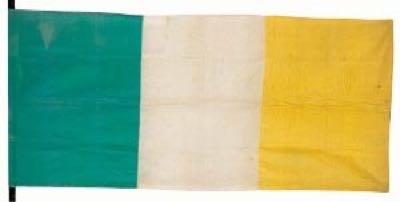
The only known surviving example of the flag of the Irish Republic proclaimed by Patrick Pearse, the hand-made tricolor flown over the G.P.O. in Dublin in the Easter Rising, 1916, will be sold in New York on Tuesday 23 March. Details here.
Hand-Made
An interesting blog by Jessica Pigza, of the Rare Book Division of the New
York Public Library. I liked her discussion of The Week-End Book by
the Meynells.
http://nypl.org/blog_series/hand-made
Recent Reading :
— Jon A. Jackson. Grootka (1990 ; Dell, 1992)
[RR].
6 March 10
‘ The Blue Star ’ ; or the ice-cold jewel
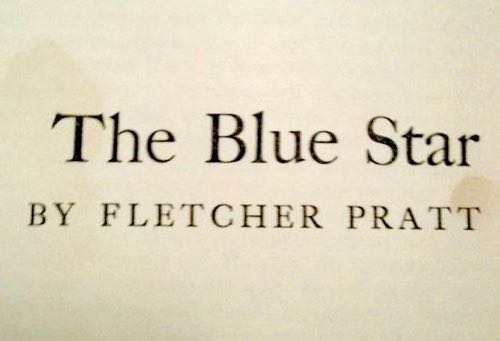
— Fletcher Pratt. The Blue Star . [pp. 223-423
in :] Witches Three , Twayne Publishers, 1952. Ballantine
Books paperback, 1969.
The Blue Star is one of the favorite books of the
Endless Bookshelf, for the perennially rewarding complexities and
turns of its narrative, generally, and for three specific reasons :
1. the frame story is overt and itself a fantasy in the club story mode, and Lalette Asterhax, the principal character, is explicitly aware of the existence of the frame story at a key point in the narrative crisis
2. the secondary world is complex and fully functional (with revolutionary politics and conflicting theologies)
3. and it is a fantasy novel about the renunciation of magical powers.
Lalette Asterhax, descendant of a witch-family in this matrilineal society, escapes one immediate peril for a succession of misfortunes when she and Rodvard Bergelin become lovers. Rodvard “ Yes-and-No ” is an idealistic member of the the revolutionary band the Sons of the New Day who seek to overthrow the entrenched interests governing Dossola. As Lalette’s lover, he bears the eponymous blue star, “ the ice-cold jewel ” that grants him the ability to discern the true thoughts of others and thus makes him a precious asset for the revolution. Lalette is separated from him for much of the novel ; poverty, unctuous deception, and the undesired attentions of other men all play a part in her ordeals. The lovers are re-united, their decision is irreversible.
The languages and names — Tritulaccan, Mancherei, Otrug, Kjermanash, Kazmerga, for example — play well upon the ear and tongue, and Pratt evolved an interesting means of denoting the private thoughts of specific characters : short parenthetical intrusions into the narrative line, the most powerful of these are literal flashes of lightning. Pratt’s novel is rich in ambiguities ; but the novel admits no sequel :
For an enchanted moment they stood so. Then Rodvard’s hands went to his neck, and with a swift motion, he drew out the Blue Star, over his head and holding it in his hand, glanced at the stream and then at Lalette.
“ Yes, ” she said. It made only a small splash where it struck the water.

Your correspondent’s copy of The Blue Star is atypical, for it is Pratt’s novel extracted from a dampstained wreck of the original Twayne Triplet publication and bound by hand in blue-purple cloth. I have a complete copy of the orginal in the attic ; the other two tales in the volume are Conjure Wife by Fritz Leiber and There Shall Be No Darkness by James Blish. A Ballantine paperback edition was published in 1969 :

The chapter in Literary Swordsmen and Sorcerers by L. Sprague de Camp (1976) places Pratt in the literature of the fantastic and gives a good sense of how the two writers collaborated. I have written elsewhere about Pratt’s other novel, The Well of the Unicorn (1948). This present note is a suitable occasion to post a digital version of “ Fletcher Pratt, Military & Naval Historian ”, originally published in AB Bookman’s Weekly for 30 June 1997.
Looking through my folder (and the string of notations of page numbers on the endpapers of The Blue Star and The Well of the Unicorn ), I see that I have not entirely exhausted my interest in Fletcher Pratt. One small sample below (from a photocopy of a clipping from the Asbury Park Evening Press, 30 January 1956) :

The house, known as the Ispsy-Wipsy Institute, was sold after Pratt’s death, and burned down in the early 1960s — “ . . . the right way to go, a clean way. It was a holiday sort of house. Now it’ll never be desecrated by humdrum living. ” Stone pillars and old holly bushes remain at the entrance drive. Not too long ago, I visited the town and the wartime naval battery, now Hartshorne Woods Park.
Tumblin’ Dice

— Ricky Jay. Dice. Deception, Fate & Rotten Luck . Photography and afterword by Rosamond Purcell. The Quantuck Lane Press, [2003]. Delightful, erudite, and startling : a great short essay about ordinary objects, with dazzling photographs of celluloid dice in various stages of autolysis by that connoisseur of decay, Rosamond Purcell. A gift of the author, Dice claims a permanent place on the shelf alongside such titles as Thrift Store and Dream Books and The Smell of Telescopes . The photograph below links to the Museum of Jurassic Technology, where some of the dice are are displayed.
3-4 March 10
Hand Made Books
— Sarah Horowitz. Alpha Botanica . Wiesedruck, 2007. Two botanical alphabets (Roman and Hebrew) by the artist, edition of 45 copies, hand bound by Claudia Cohen.
— Claudia Cohen. Counting . Heavenly Monkey Editions, 2009. Numbers and counting, with stamps “ designed for the Dutch Post Office by Jan van Krimpen, type designer, typographer & calligrapher extraordinaire. The stamps on the title page are all his. The remaining stamps, as well as the ornaments . . . all relate to van Krimpen’s interlaced calligraphic flourishes ” (from the colophon). Edition of 20 copies, hand bound by Claudia Cohen in old German Buntepapier.
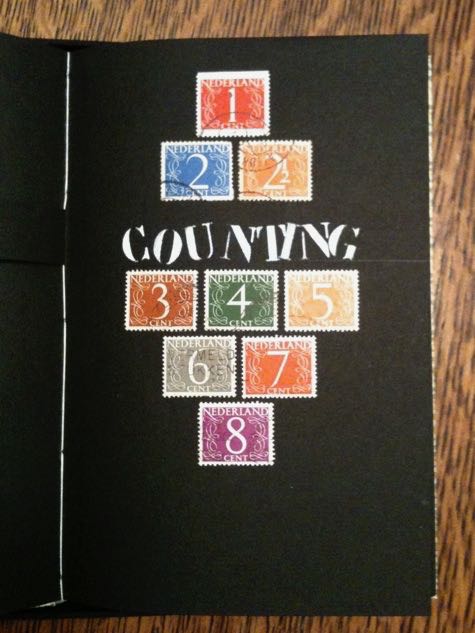
Recent reading :
— Philip Babcock Gove. The Imaginary Voyage in Prose Fiction. A History of Its Criticism and a Guide for Its Study, with an Annotated Check List of 215 Imaginary Voyages from 1700 to 1800 . (1941 ; Octagon Books, 1975).
Interesting and wide-ranging polyglot study of the imaginary voyage in fiction, not only Robinson Crusoe and Gulliver’s Travels but also the hundreds of other books in this mode. Some useful reflections on how terminology shapes thinking. “ Genres in fiction are far from rigid anyway; their usefulness as conventions often depends upon their flexibility . . . . But definitions are rigid, and those who wish to form a definition of a genre should not forget that such a definition is only a temporary and arbitrary means to an end. ” The review of the critical literature identifies nuances and categories within the mode ; and the discussion of robinsonades in particular traces a long-established tradition of critical interest in the imaginary voyage. [There are a few other points I will note tomorrow. HW]
Straight from the Printer

Ñ Michael Zinman. Hard Times . Annals of Collecting 2. Privately printed, 2010. Detail of cover below :

Shy Bird
— Charles Eilers. “ It’s a Shy Bird : The Life and Times of the U.S. Copyright Edition of Seven Pillars of Wisdom ”. Long Beach, California, 2009. Detailed and scrupulously referenced account of the printing and publication history of the copies of The Seven Pillars of Wisdom (note definite article) printed by George H. Doran to secure U.S. copyright in 1926, with a thorough review of the different bindings and whereabouts of known copies. Eilers quotes extensively from the correspondence between T.E. Lawrence, Doran, Richard Savage (Lawrence’s agent), and others. Revealing of the degree of control which Lawrence exercised over the distribution of his text during his lifetime. And how, despite Lawrence’s insistence that the “ spoiled proofs ” of the English edition used to set the U.S. copyright edition be returned to him, they ended up with Bruce Rogers, who commissioned and published the translation of the Odyssey that would occupy Lawrence for the next several years. I look forward to seeing the essay reach its final form in a bibliographical or scholarly journal.
Wander in the Archives
The Archives of the Endless Bookshelf have been swept and tidied and a guide has been prepared to assist wanderers. Index would be too strong a term : the headwords tend to be suggestive rather than directive. Start here. Have fun.
This creaking and constantly evolving website of the endless bookshelf : I expect that some entries will be brief, others will take the form of more elaborate essays, and eventually I will become adept at incorporating comments or interactivity. Right now you’ll have to send links to me, dear readers. [HWW]
electronym : wessells
at aol dot com
Copyright © 2007-2010
Henry
Wessells and individual contributors.
Produced by Temporary
Culture, P.O.B. 43072, Upper Montclair, NJ 07043 USA.
